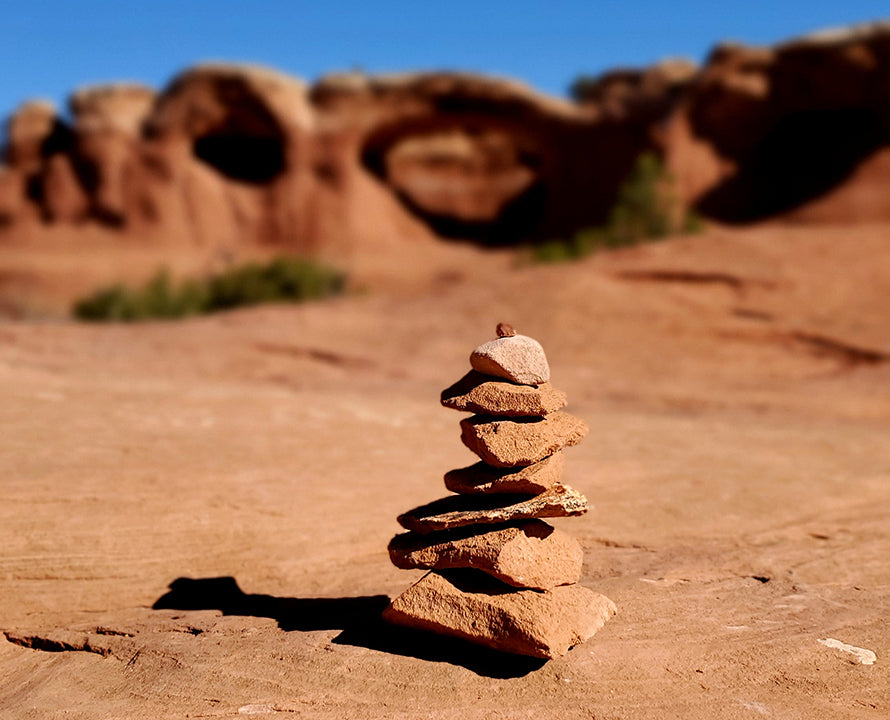When you're out on the trail, sometimes the path ahead isn't as clear as you'd like it to be. You might find yourself pondering which way to go, like a lost squirrel in the woods. But fear not, intrepid hikers, because nature has provided us with a clever solution: trail cairns! These whimsical stacks of rocks are like Mother Nature's signposts, guiding us through the wilderness.

Trail Cairn Example
Picture yourself deep in the wilderness, surrounded by the beauty of nature. You're on a trail, unsure of which path to take. That's where trail cairns come to the rescue! In this blog post, we'll explore the world of trail cairns, why they are essential, how to use them effectively, and what to avoid.
I know I personally have relied on them numerous times to find my way through trails that I otherwise would have got lost on. Particularly when I was visiting Arches National Park and took some wrong turns, the cairns got me back on track to safely enjoy my hike.
Why We Need Trail Cairns:
- The Gift of Direction:
Trail cairns are like the breadcrumbs left by Hansel and Gretel but much more reliable. They guide us through the maze of trails, ensuring we don't lose our way in the wild.
- Preservation of Nature:
By following cairns, we help preserve the environment. Staying on designated paths reduces our impact on delicate ecosystems.
 If you start to get lost look for these little stacked rocks to guide you
If you start to get lost look for these little stacked rocks to guide you
How to Use Trail Cairns:
- Keep Your Eyes Peeled:
While hiking, stay vigilant. Trail cairns can sometimes be inconspicuous. Scan the landscape for those carefully stacked stones.
- Follow the Leader:
Trust the cairns. If they lead, follow. Cairns are usually placed strategically to keep you on the right track.
- Maintain Respect:
Do not disturb or disassemble cairns for fun. They serve a crucial purpose and tampering with them disrupts navigation for others.
What Not to Do:
- Don't Build Unauthorized Cairns:
Leave cairn construction to park authorities. Creating your own could lead others astray and harm the environment.
- Avoid Overloading Cairns:
Adding extra rocks to a cairn can make it unstable and less effective. Stick to the original design.
- Don't Rely Solely on Cairns:
While cairns are excellent aids, they should complement your map, compass, and other navigation tools. Relying solely on them can be risky. Google Maps is ALWAYS a lifesaver for me when I'm out hiking, I wouldn't go on any hike without it.
 Look for native wood, branches, logs, etc. in place of cairns blocking wrong trails
Look for native wood, branches, logs, etc. in place of cairns blocking wrong trails
Pros of Trail Cairns:
- Navigation Nirvana: Cairns are like breadcrumbs in the forest, leading you safely to your destination. They're especially handy in areas with limited signage or confusing intersections.
- Low-Tech and Low-Cost: Unlike GPS devices or maps, cairns require no batteries or Wi-Fi connections. Plus, they're practically free, as nature provides the building blocks for these stone sculptures.
- Leave No Trace: Cairns are a Leave No Trace-friendly way to mark a trail. They don't harm the environment and can be easily dismantled once they're no longer needed.
- Art in Nature: Building and spotting cairns can be an enjoyable and creative part of your hiking experience. It's like a natural art gallery, with each stack of rocks telling its own story.
- Teamwork Triumph: If you're hiking with a group, building a cairn together can be a fun bonding experience. It's teamwork at its finest, and you'll have a unique marker to remember the adventure by.
Cons of Trail Cairns:
- Overload Overkill: In popular hiking spots, cairns can multiply like rabbits, creating confusion rather than clarity. Too many cairns can lead you astray, as not all of them are reliable markers.
- Erosion Evasion: Building cairns can disrupt local ecosystems by removing rocks and disturbing the natural landscape. This can lead to soil erosion and habitat disruption.
- Respect the Rocks: Some hikers may go overboard with cairn construction, taking rocks from fragile environments where they're needed. It's essential to use existing rocks and not deplete the environment.
- Historical Sites and Indigenous Lands: In certain areas, cairns may have cultural or historical significance. Inadvertently knocking them over or adding new cairns can be disrespectful or even illegal.
- Maintenance Mayhem: Cairns require ongoing maintenance as they can be knocked down by wildlife, weather, or other hikers. Neglected cairns can become misleading and potentially dangerous.
 Trail Carins come in all shapes and sizes of rocks
Trail Carins come in all shapes and sizes of rocks
In conclusion, trail cairns are like quirky forest guardians, helping us find our way in the wilderness. They offer a host of benefits, from guiding lost souls to being eco-friendly and cost-effective. However, like any tool, they have their drawbacks, especially when overused or misused.
So, the next time you encounter a trail cairn, take a moment to appreciate its unique charm. Just remember to use them responsibly, respect the environment, and keep in mind that nature is full of delightful surprises, even without those stacks of rocks. Happy hiking!


